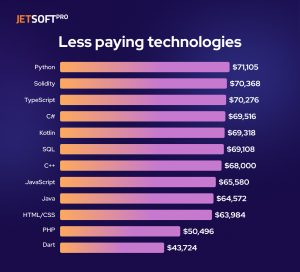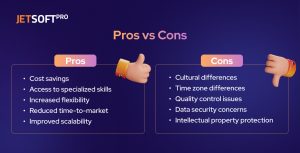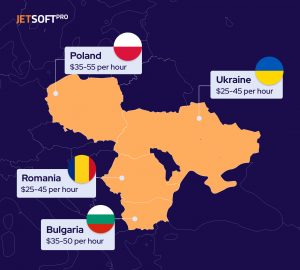Software development has become an essential aspect of business operations for companies across industries. From simple applications to complex enterprise solutions, businesses need software to automate processes, manage data, and make informed decisions. However, the speed at which software is developed can vary greatly depending on various factors. In this article, we’ll explore the average software development rate in the market and provide statistics to help you better understand the industry.

The average software development rate varies widely depending on the type of software being developed, the development methodology used, the complexity level, and the development team’s experience. However, according to a survey conducted by the online software development marketplace, Upwork, the average hourly rate for software development is $30-$120. The survey collected data from over 1,000 US-based software development companies and found that the hourly rate varied depending on the specific skills required for the project. For example, software developers with expertise in artificial intelligence or blockchain development can command a higher rate, averaging $100-$200 per hour.
Another study by Clutch, a B2B research firm, found that the average cost of custom software development ranges from $75,000 to $500,000. The study surveyed 529 companies and found that the size of the company and the level of customization required were the two most significant factors influencing the cost of software development. Smaller companies with more specific software requirements paid less than larger companies with complex needs.
Regarding the speed of software development, the industry has seen a significant shift towards agile methodologies. Agile is a software development approach that emphasizes iterative development, continuous delivery, and customer collaboration. According to the 14th Annual State of Agile Report, 95% of surveyed organizations use agile methodologies, with Scrum being the most popular framework. The report also found that organizations that adopted agile methodologies saw a 53% increase in software delivery speed compared to traditional methods.
Factors that Affect Software Development Rates
There are several factors that can affect software development rates, including:
- The complexity of the Project: The complexity of the project will affect the amount of time and effort required to complete it. A simple project will require less time and effort than a complex one. A project involving complex features like artificial intelligence or machine learning algorithms will require developers to have specialized skills, which may result in higher development costs.
- Skill Level of the Development Team: The skill level of the development team will affect the speed and quality of the work. A team with more experienced developers will likely be able to work more efficiently and produce higher-quality code in a shorter amount of time. If a client hires a team of experienced developers to work on their project, they can expect to pay more for their services than if they hired a team of junior developers.
- Technology Stack: The technology stack chosen for the project can affect development rates. Some technologies may be easier to work with than others, which can affect development speed and quality. If a project requires the use of expensive proprietary software or specialized hardware, the cost of development will be higher compared to using open-source software or more commonly used hardware.
- Scope of the Project: The scope of the project will determine the amount of work required to complete it. A larger project will require more time and resources than a smaller one. If a project has poor project management practices, it may result in missed deadlines, which can lead to additional costs, such as the need for developers to work overtime or hire additional staff.
- Project Management: The effectiveness of project management can affect development rates. A well-managed project will be more likely to stay on track and avoid delays, while a poorly managed project may experience delays and cost overruns. If there is poor communication between the development team and the client, there may be misunderstandings that require additional development work, leading to higher costs.
- Communication: Effective communication between the development team and stakeholders is crucial for keeping the project on track and avoiding misunderstandings that can cause delays. If a client hires developers in a high-cost location like Silicon Valley, they can expect to pay more for their services than if they hired developers in a lower-cost location like India.
- Location: The location of the development team can affect development rates. Developers in certain regions may have higher rates than others due to differences in cost of living and other factors. A project with a large scope may require more developers, leading to higher costs. For example, a project that requires the development of a complex e-commerce platform with multiple features would require more developers than a simple website.
- Timeframe: The timeframe for the project can also affect development rates. Rushed projects may require more resources and may result in lower-quality work. If a project has a tight deadline, developers may need to work overtime to complete the work on time, leading to higher costs. On the other hand, if a project has a longer timeline, the cost of development may be lower as developers have more time to complete the work.
Types of Software Development Rates
Software development pricing models refer to the different approaches that software development companies use to determine the costs of their services. The pricing model adopted by a software development company will have a significant impact on its revenue, profit margin, and overall success of the business. Here are some of the most common software development pricing models:
Fixed Price Model: This model involves a fixed price for a specific project, regardless of the actual time and resources required to complete it. This model is suitable for projects with a well-defined scope, timeline, and requirements. The advantages of this model are that the client has a clear idea of the project cost and timeline, and the software development company can accurately predict its revenue. However, this model can lead to lower-quality work, as developers may rush to meet deadlines and deliverables.
Time and Material Model: This model involves billing clients based on the time and resources used for a particular project. The client pays for the actual hours worked by the developers and the materials and resources used. This model is suitable for projects with a high level of uncertainty or those with changing requirements. The advantages of this model are that it is flexible and transparent and encourages collaboration between the client and the development team. However, it can be difficult to predict the overall project cost, and the client may end up paying more than expected if the project runs over time.
Cost Plus Model: This model involves billing clients based on the actual cost of the project, plus a markup for profit. The client pays for the project’s total cost, including salaries, overhead costs, and any other expenses, plus a percentage markup. This model is suitable for long-term projects.
Retainer: A retainer is a pre-agreed amount that the client pays the engineer for a specific period. The engineer is required to be available to work on the project during this period.
Equity-based compensation: In some cases, engineers may receive equity in the company instead of cash compensation. This model is more common in startup companies where the engineer’s contribution is essential to the company’s success.
The choice of payment rate model depends on the project’s scope, duration, complexity, and the engineer’s experience and skill level. It’s essential to choose a fair payment model that incentivizes the engineer to deliver quality work.
Average Software Development Rates by Region
The average rate of a developer can vary widely depending on several factors, including their experience level, skillset, industry, and region. Below are some approximate ranges for developer rates by region based on available data:

North America:
- United States: $60-$150+ per hour
- Canada: $50-$120+ per hour
According to Salary.com, the average base pay for software developers in the United States typically falls between $108,444 and $128,546. However, this number can vary significantly depending on the location. For instance, the average salary for a software developer in San Francisco is around $147,735 per year, which is considerably higher than the national average. On the other hand, the average salary for a software developer in smaller cities or rural areas may be lower.
Europe:
- United Kingdom: $42-$120+ per hour
- Germany: $63-$130+ per hour
- France: $43-$110+ per hour
According to PayScale, the average salary for software developers in Europe is around $46,000 per year. However, this number can vary significantly depending on the country and city. For instance, the average salary for a software developer in Switzerland is around CHF 99,000 per year (which is equivalent to around $97,000), which is considerably higher than the European average. On the other hand, the average salary for a software developer in countries like Romania, Bulgaria, or Poland may be lower than the European average.
Switzerland, Norway, Denmark, and Sweden are among the highest-paying countries for software developers in Europe. In these countries, the average salary for a software developer can range from $64,000 to $97,000 per year. Other countries such as the UK, Germany, France, and the Netherlands also offer competitive salaries for software developers, with the average salary ranging from $48,000 to $69,000 per year.
On the other hand, countries such as Romania, Bulgaria, and Poland are among the countries where software developers are paid less. In these countries, the average salary for a software developer can range from $16,000 to $32,000 per year. However, it is worth noting that the cost of living in these countries is considerably lower than in Western European countries.
Asia:
- India: $12-$30+ per hour
- China: $29-$116+ per hour
- Japan: $38-$135+ per hour
Software development rates in Asia can vary significantly depending on a variety of factors such as the country, city, industry, experience level, and specific technology expertise. Generally, countries such as Japan, South Korea, and Singapore tend to have higher salaries for software developers, while countries such as India, Indonesia, and the Philippines have lower salaries.
Japan is known to have some of the highest software developer salaries in Asia, with an average annual salary of around 7.5 million yen (approximately $69,000 USD) for mid-level developers. This is due in part to the high cost of living in major cities such as Tokyo and Osaka, as well as the high demand for skilled developers in industries such as finance and manufacturing.
Similarly, South Korea has a high demand for software developers, particularly in the gaming and electronics industries. According to data from PayScale, the average annual salary for software developers in South Korea is around 47 million KRW (approximately $41,000 USD) for mid-level developers.
Singapore, which is known for its thriving tech industry, also has relatively high software developer salaries. According to data from Glassdoor, the average annual salary for software developers in Singapore is around $70,000 USD.
On the other hand, countries such as India, Indonesia, and the Philippines have lower software developer salaries. In India, for example, the average annual salary for mid-level software developers is around 1.2 million INR (approximately $16,000 USD), while in the Philippines, the average annual salary for mid-level software developers is around 489,000 PHP (approximately $9,600 USD).
Average Software Development Salary depending on Programming Languages


Outsourcing can help to cut expenses on software development and have lower rates.
Outsourcing can help cut expenses on software development and reduce rates. There are several ways that companies can cut costs for custom software development without compromising on the quality of the product, but the most commonly used method is outsourcing.
Outsourcing software development to offshore or nearshore destinations has become a popular strategy for companies looking to reduce costs and increase efficiency. Offshore outsourcing refers to outsourcing software development to a company located in a different country, while nearshore outsourcing involves outsourcing to a company located in a neighboring country. 
The benefits of outsourcing software development to offshore or nearshore destinations include:
- Cost savings: Offshore and nearshore destinations often have lower labor costs, which means that companies can save money on software development.
- Access to specialized skills: Companies can access specialized skills that may not be available locally, which can be especially important in areas such as artificial intelligence, machine learning, and blockchain technology.
- Increased flexibility: Outsourcing software development allows companies to quickly ramp up or down their development resources as needed.
- Reduced time-to-market: Outsourcing software development can help companies get their products to market faster by leveraging the expertise of offshore or nearshore development teams.
- Improved scalability: Offshore and nearshore development teams can help companies scale their software development resources more easily than if they were relying solely on local resources.
However, outsourcing software development to offshore or nearshore destinations also carries potential risks, including:
- Cultural differences: Cultural differences can lead to misunderstandings or communication difficulties between the outsourcing company and the development team.
- Time zone differences: Time zone differences can make it difficult to communicate and collaborate effectively with offshore or nearshore development teams.
- Quality control issues: Quality control can be more challenging when working with a remote team, especially when there are language or cultural barriers.
- Data security concerns: Outsourcing software development to a company located in a different country may raise data security concerns, especially if the company is located in a country with weak data privacy laws.
- Intellectual property protection: There may be legal challenges in protecting intellectual property when working with an offshore or nearshore development team.
Companies should carefully select their outsourcing partners to mitigate these risks and establish clear communication and collaboration protocols. It is also important to establish robust data security and intellectual property protection measures to protect the company’s intellectual property throughout the outsourcing process.
Overall, outsourcing custom software development to offshore or nearshore destinations can be a powerful strategy for companies looking to reduce costs, access specialized skills, and improve their time-to-market. However, it is important to carefully consider the potential risks and take steps to mitigate them to ensure a successful outsourcing partnership.
What are the biggest IT outsourcing hubs in Eastern Europe?
Eastern Europe has become a popular destination for IT outsourcing due to the availability of highly skilled and educated IT professionals, competitive prices, and favorable time zone overlap with Western Europe. Some of the key IT outsourcing hubs in Eastern Europe include:

Ukraine: Ukraine is the largest IT outsourcing hub in Eastern Europe, with a highly skilled workforce and competitive prices.
Poland: Poland is also a popular destination for IT outsourcing due to its large pool of skilled developers, cultural compatibility with Western Europe, and strong government support for the tech industry.
Romania: Romania has a strong reputation for software development and IT outsourcing, with a skilled workforce and a growing startup ecosystem.
Bulgaria: Bulgaria has a well-educated and multilingual workforce, with a growing startup scene and competitive prices for IT outsourcing services.
Other countries in the region, such as the Czech Republic, Hungary, and Slovakia, also have a growing IT outsourcing industry and skilled IT workforce.
Why outsource to Ukraine?
Outsourcing software development to Ukraine has become increasingly popular in recent years due to its numerous advantages. Here are some of the key benefits of outsourcing software development to Ukraine:
Access to a large pool of highly skilled and experienced developers: Ukraine has a strong IT industry with over 200,000 IT professionals. According to the Ukrainian Hi-Tech Initiative, the country ranks fourth in the world for the number of certified IT professionals, which means that a large pool of highly skilled and experienced developers is available for outsourcing projects.
Cost savings: Outsourcing software development to Ukraine can provide significant cost savings compared to hiring in-house developers or outsourcing to other countries. According to a survey by Clutch, the average hourly rate for a software developer in Ukraine is around $40, much lower than rates in the United States and Western Europe.

Time zone advantage: Ukraine is in a favorable time zone for outsourcing to North America, Europe, and Asia. This means that communication and collaboration between the outsourcing team and the client can be streamlined and efficient.
High-quality work: Ukrainian developers are known for their high-quality work and attention to detail. They are also proficient in English, which ensures effective communication between the outsourcing team and the client.
Favorable business environment: Ukraine has a stable political and economic climate and a favorable business environment. The country has made significant strides in improving its business regulations and attracting foreign investment.
JetSoftPro can be an excellent outsourcing partner for companies seeking to improve their technology solutions, particularly in renewable energy and custom software development. One key advantage of working with JetSoftPro is its strong reputation, as evidenced by its positive Clutch reviews. Our expertise in custom technology solutions is another central selling point. We have experienced developers, designers, and project managers who can tailor their services to meet a wide range of client needs, from developing new software platforms to integrating existing systems. Additionally, our experience in renewable energy software solutions, WFM (workforce management), and drone management solutions makes us a solid choice for companies in this industry.

